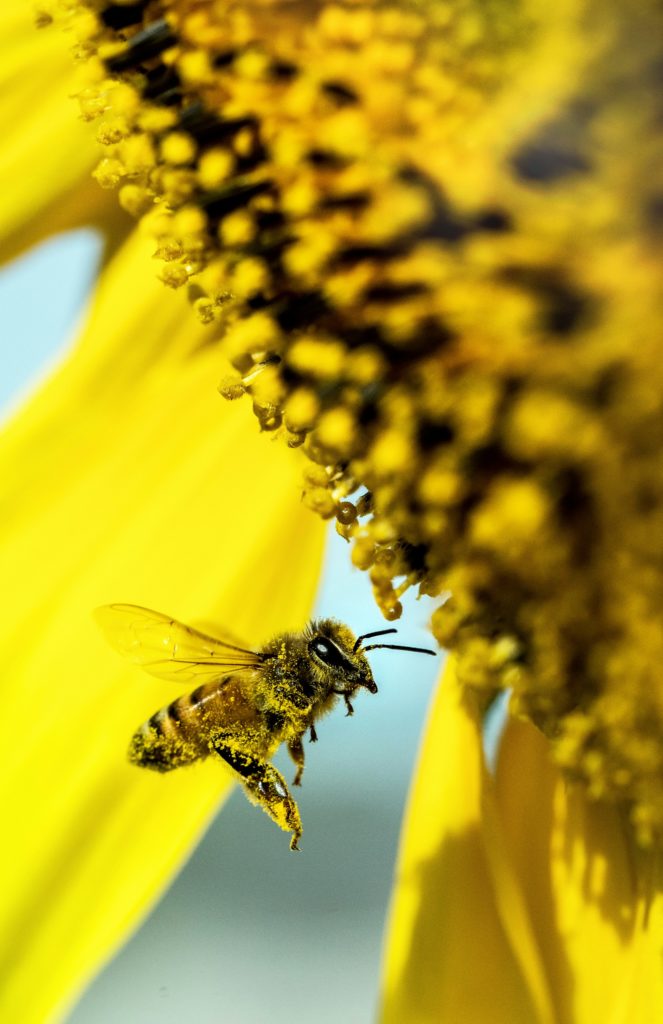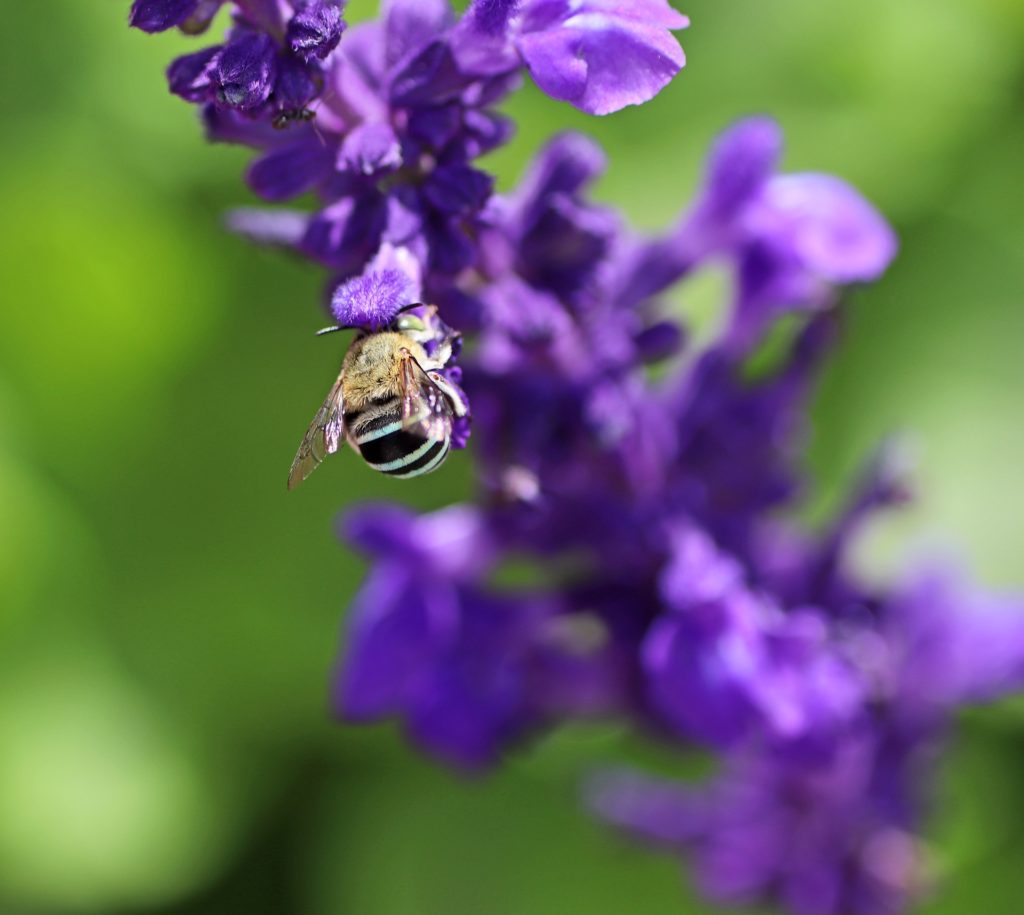Saving the Bee-cosystem
By Lejla Kartal
The Peter Doherty Institute for Infection and Immunity
How can we help our bees help the planet?

Bees play an essential part in the ecosystem, supporting countless plants and crops through pollination. ‘Save the bees’ has been a popular slogan for well over a decade – but while the slogan came about because of European honeybees dying in large numbers, bees may yet be in more trouble than we thought, particularly wild species.1
Catastrophic bushfires ravaged Australia in the 2019-2020 summer, with devastating effects on our wildlife. It has been estimated that the number of threatened bee species in Australia nearly quadrupled after these fires, jumping from 3 to 11.2 Combined with overall declines in bee populations in recent years, this paints a grave picture for our bees’ future.
Fortunately, there are ways we can help!
Although backyard beekeeping has become quite popular, this mostly supports the European honeybee. Backyard beekeeping supports food production and promotes pro-environmental behaviour, meaning people are more likely to take care of the environment, but honeybees can pose risks to wild pollinators in cities.4 European honeybees are not a replacement for wild, native bees, which are essential for maintaining biodiversity in the ecosystem.1,5
It’s unclear exactly how many native species of bee there are in Australia, but it could be as many as 2,000.6,7 Our native bee species are diverse in behaviour and appearance: many are solitary and build individual nests using plant materials like silk and resin, some burrow into the ground, and some native bees are even blue.7

How do we support them all?
The best way to support bees is by having diverse, native green spaces. By planting native flowers, shrubs, and trees, we give our bees the best chance of finding a home that suits them.7 Even planting native plants scattered around non-native flowers or crops is enough to make a difference.7,8 Having a classic bottlebrush (Callistemon spp.) or eucalyptus in the garden does wonders, especially in urban areas like Melbourne.7
Other ways to help native bees include making a bee hotel, or letting patches of garden become “messy” by less-frequent lawn mowing or leaving some dying vegetation to provide places for ground-nesting bees to hide and burrow.7,9
Supporting native bee populations in our gardens aids conservation efforts, benefits our gardens themselves, and also helps protect their important role as pollinators. In fact, native bees have actually been unaffected by the recent Varroa mite outbreak in NSW that has been so devastating for the European honeybee.10 Native bees could potentially act as an insurance plan in the wake of the outbreak, as they have been shown to sufficiently pollinate crops in the US while European honeybees recover.11
Ultimately, maintaining a diverse garden has so many benefits for our environment, there’s no reason not to. Plus, it means we can all play a part to help the bees, so they can continue to play their part in the bee-cosystem.
—
Lejla Kartal is a PhD student at the Peter Doherty Institute for Infection and Immunity. She has a Master of Science (Epidemiology) and is now studying how tiny viruses called bacteriophages can be used to kill antibiotic resistant bacteria.
References:
- Iwasaki, J. M., & Hogendoorn, K. (2021). How protection of honey bees can help and hinder bee conservation. Current Opinion in Insect Science, 46, 112–118. doi.org/10.1016/J.COIS.2021.05.005
- Dorey, J. B., et al. (2021). Continental risk assessment for understudied taxa post-catastrophic wildfire indicates severe impacts on the Australian bee fauna. Global Change Biology, 27(24), 6551–6567. doi.org/10.1111/GCB.15879
- IPBES. (2019). Global assessment report on biodiversity and ecosystem services of the Intergovernmental Science-Policy Platform on Biodiversity and Ecosystem Services. doi.org/10.5281/zenodo.6417333
- Egerer, M., & Kowarik, I. (2020). Confronting the Modern Gordian Knot of Urban Beekeeping. Trends in Ecology & Evolution, 35(11), 956–959. doi.org/10.1016/J.TREE.2020.07.012
- Carrié, R., et al. (2017). Relationships among ecological traits of wild bee communities along gradients of habitat amount and fragmentation. Ecography, 40(1). doi.org/10.1111/ecog.02632ï
- Batley, M., & Hogendoorn, K. (2009). Diversity and conservation status of native Australian bees. Apidologie, 40(3), 347–354. doi.org/10.1051/APIDO/2009018
- Houston, T. (2018). A Guide to Native Bees of Australia. Guide to Native Bees of Australia. doi.org/10.1071/9781486304073
- Prendergast, K. S., et al. (2021). Honey bees (Hymenoptera: Apidae) outnumber native bees in Tasmanian apple orchards: Perspectives for balancing crop production and native bee conservation. Austral Entomology, 60(2), 422–435. doi.org/10.1111/AEN.12521
- Threlfall, C. G., et al. (2015). The conservation value of urban green space habitats for Australian native bee communities. Biological Conservation, 187, 240–248. doi.org/10.1016/J.BIOCON.2015.05.003
- Varroa mite (Varroa destructor). (2023, September 12). Outbreak; Department of Agriculture. outbreak.gov.au/current-outbreaks/varroa-mite
- Winfree, R., et al. (2007). Native bees provide insurance against ongoing honey bee losses. Ecology Letters, 10(11), 1105–1113. doi.org/10.1111/J.1461-0248.2007.01110.X








